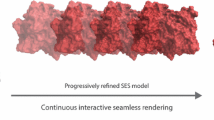Abstract
A method for visualizing multivolume data and functionally defined surface using graphics processing units is proposed. The method provides visualization of a large number of volumes, a complex of semi-transparent and functionally defined objects, of complex semi-transparent volumes, including intersections of volumes in constructive solid modeling. Simultaneous rendering of different volumes is more difficult than rendering of a single volume, because both intersecting and blending operations are required. Functionally defined surfaces are well suited for embedding external objects into volumes.






Similar content being viewed by others
REFERENCES
J. Kruger and R. Westermann, ‘‘Acceleration techniques for GPU-based volume rendering,’’ in Proc. of the 14th IEEE Conf. on Visualization, Seattle, USA, 2003, pp. 38–43. https://doi.org/10.1109/VISUAL.2003.1250384
S. Stegmaier, M. Strengert, T. Klein, and T. Ertl, ‘‘A simple and flexible volume rendering framework for graphics-hardware-based ray casting,’’ in Proc. of the 4th Eurographics, IEEE VGTC Conf. on Volume Graphics, New York, USA, 2005, pp. 187–195. https://doi.org/10.1109/VG.2005.194114
B. B. Avants, N. J. Tustison, G. Song, P. A. Cook, A. Klein, and J. C. Gee, ‘‘A reproducible evaluation of ANTs similarity metric performance in brain image registration,’’ Neuroimage 54, 2033–2044 (2011). https://doi.org/10.1016/j.neuroimage.2010.09.025
R. J. Killiany, T. Gomez-Isla, M. Moss, R. Kikinis, T. Sandor, F. Jolesz, R. Tanzi, K. Jones, B. T. Hyman, and M. S. Albert, ‘‘Use of structural magnetic resonance imaging to predict who will get Alzheimer’s disease,’’ Ann. Neurology 47, 430–439 (2000). https://doi.org/10.1002/1531-8249(200004)47:4<430::AID-ANA5>3.0.CO;2-I
A. Leu and M. Chen, ‘‘Modelling and rendering graphics scenes composed of multiple volumetric datasets,’’ Comput. Graph. Forum. 18, 159–171 (1999). https://doi.org/10.1111/1467-8659.00366
S. Grimm, S. Bruckner, A. Kanitsar, and M. E. Groller, ‘‘Flexible direct multi-volume rendering in interactive scenes,’’ in Proc. of the Vision, Modeling, and Visualization Conference (VMV 2004), Stanford, USA, 2004, pp. 386–379.
S. I. Vyatkin, ‘‘Complex surface modeling using perturbation functions,’’ Optoelectron., Instrum. Data Process. 43, 226–231 (2007). https://doi.org/10.3103/S875669900703003X
S. I. Vyatkin, ‘‘Conversion of functionally defined forms,’’ Software Syst. Comput. Methods, No. 4, 489–499 (2014). https://doi.org/10.7256/2305-6061.2014.4.13982
S. I. Vyatkin and B. S. Dolgovesov, ‘‘Compression of geometric data with the use of perturbation functions,’’ Optoelectron., Instrum. Data Process. 54, 334–339 (2018). https://doi.org/10.3103/S8756699018040039
S. I. Vyatkin, ‘‘Method of binary search for image elements of functionally defined objects using graphics processing units,’’ Optoelectron., Instrum. Data Process. 50, 606–612 (2014). https://doi.org/10.3103/S8756699014060090
S. I. Vyatkin, ‘‘Recursive search method for the image elements of functionally defined surfaces,’’ Optoelectron., Instrum. Data Process. 53, 245–249 (2017). https://doi.org/10.3103/S8756699017030074
G. Knittel, ‘‘VERVE: voxel engine for real-time visualization and examination,’’ Comput. Graph. Forum 12 (3), 37–48 (1993). https://doi.org/10.1111/1467-8659.1230037
S. I. Vyatkin and B. S. Dolgovesov, ‘‘A 3D texture-based recursive multi-level ray casting algorithm,’’ in Proc. of the 2nd IASTED Int. Multi-Conf. on Automation, Control, and Information Technology Software Engineering (ACIT 2005), Novosibirsk, Russia, 2005, pp. 92–97.
F. Roessler, R. P. Botchen, and T. Ertl, ‘‘Dynamic shader generation for GPU-based multi-volume ray casting,’’ IEEE Comput. Graph. Appl. 28 (5), 66–77 (2008). https://doi.org/10.1109/MCG.2008.96
R. Brecheisen, B. Platel, A. Vilanova, and B. T. H. Romenij, ‘‘Flexible GPU-based multi-volume ray-casting,’’ in Proc. of the Vision, Modelling and Visualization Conf., Konstanz, Germany, 2008, pp. 1–6.
Author information
Authors and Affiliations
Corresponding author
Additional information
Translated by E. Oborin
About this article
Cite this article
Vyatkin, S.I., Dolgovesov, B.S. A Method for Visualizing Multivolume Data and Functionally Defined Surfaces Using GPUs. Optoelectron.Instrument.Proc. 57, 141–148 (2021). https://doi.org/10.3103/S875669902102014X
Received:
Revised:
Accepted:
Published:
Issue Date:
DOI: https://doi.org/10.3103/S875669902102014X




